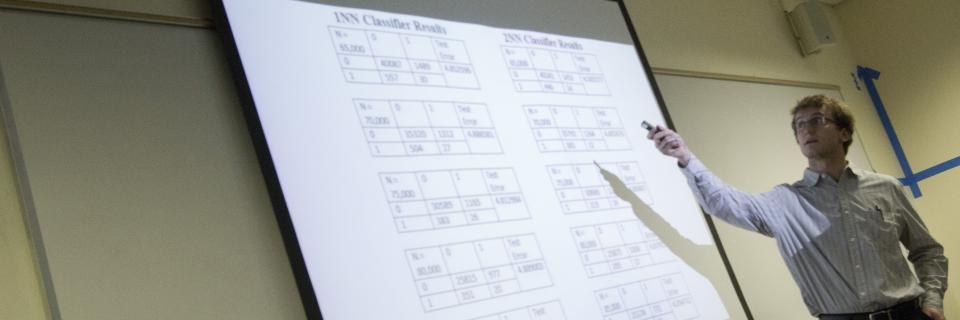Mathematics Students Test Their Knowledge with Real-World Problems

Among the age-old phrases mathematics instructors might hear in the classroom: “When am I ever going to use this?”
A class offered by Rockhurst University’s mathematics program in the spring semester provided a new answer to that question, putting groups of students in the driver’s seat of projects drawn from real life examples from the worlds of medicine, city management and Hollywood.
It’s part of a grant program offered by the Mathematical Association of America called Preparation for Industrial Careers in Mathematics that gives colleges and universities ways to incorporate applied mathematics into their curriculum. Keith Brandt, professor of math, said this is the first year the math department at Rockhurst received the grant, providing the resources used to teach the problems in industry course.
“The name says it all,” Brandt said. “The idea is to give students a look at the kinds of questions that might actually come up in their careers.”
As part of the class, each student group met and worked with project mentors from Cerner, Box Office Analyst and the city of Kansas City, Missouri, who presented their problems and met with the groups throughout the semester.
Brian O’Neal, a junior studying math and economics, said the experience was akin to the relationship a professional team might have as they work with a client.
“It was kind of like being a consultant, in the way that we worked with our mentor on finding these solutions,” he said.
The mentor for O’Neal and Lipoff’s group was Doug Stone, president of Box Office Analyst, a company that specializes in financial consulting for the movie industry. He gave the group box office data, which they used to develop a mathematical model that could accurately predict opening weekend sales given a number of criteria.
“We all talked about how we might approach this, and to some extent, it was trial and error,” said Austin Engleman, a junior studying math and education who was also a member of the team that created the box office model.
Joey Lipoff, a junior engineering and mathematics major who was the third member of O’Neal and Engleman’s group, said in addition to giving the students a feel for what a career in mathematics would be like, the problems in industry course also made the material and concepts they used seem more approachable.
Another group was asked to take medical data from Cerner and create a model that could identify the risk factors for post-partum hemorrhaging in new mothers. The third worked with the city of Kansas City to develop more efficient approaches for city building inspectors, whose caseloads and travel times were outpacing department resources.
In all three cases, the students worked with different approaches to develop their models and, to cap off the semester, presented the results to the leaders who worked with them on their projects. Stone said he was impressed with the work that the students accomplished, and said it seemed prepared for its next big test.
“I’m anxious to see how this model works,” he said.
And Brandt said the mathematics department has applied for, and received, another MAA grant to offer the PIC class in the spring 2017 semester.







